The Island Line on the Isle of Wight:
Just off the south coast of England in the English Channel is the Isle of Wight. It is just 10 minutes by hovercraft ferry from Portsmouth. It is a major holiday destination for Britons and has a reputation as a sun island. With an area of 381 square kilometres (max. 35 km long and 20 km wide) it is quite manageable, but it used to have a normal gauge railway network of 89 km in length. Only 13.9 kilometres of the route from Ryde Pier Head to the coastal town of Shanklin are still in operation from this network, which was previously quite extensive. This route has been marketed as the “Island Line” since the late 1990s and is still a fairly important link between the ferry from the mainland to the coastal towns with bathing beaches. For this purpose, it is well used in commuter traffic. In addition, the Isle of Wight Steam Railway reopened an 8.9 kilometre route. Today, this is in almost daily steam-powered operation, and is worth seeing as an historical railway although it is not the subject of this article.
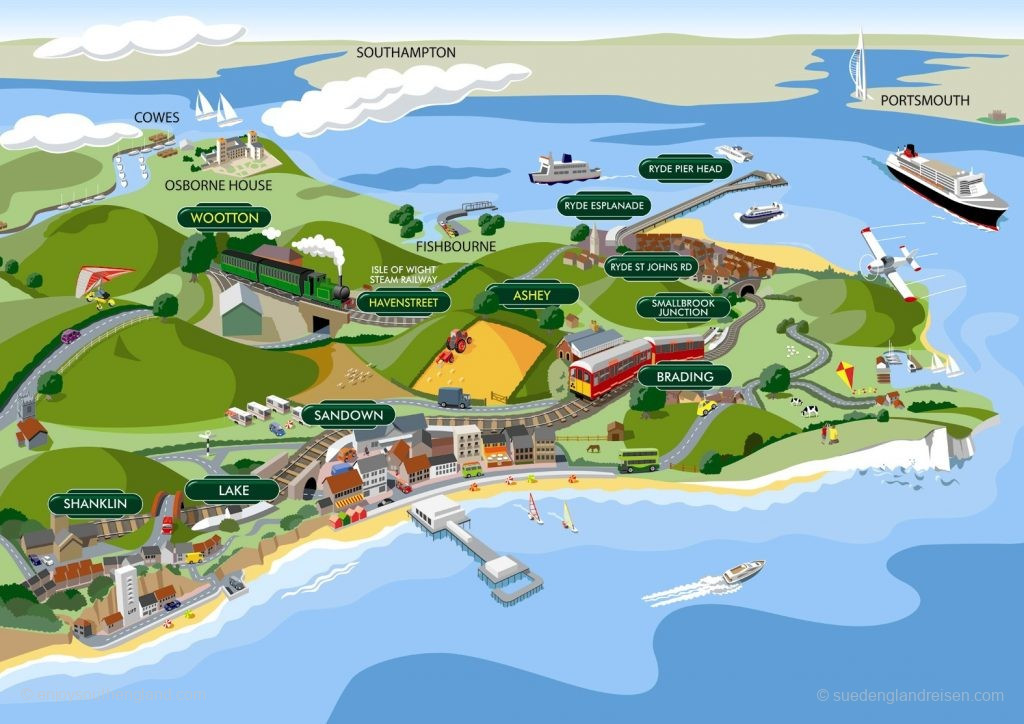
IOW Island Line – Overview (Source: SouthWest Trains)
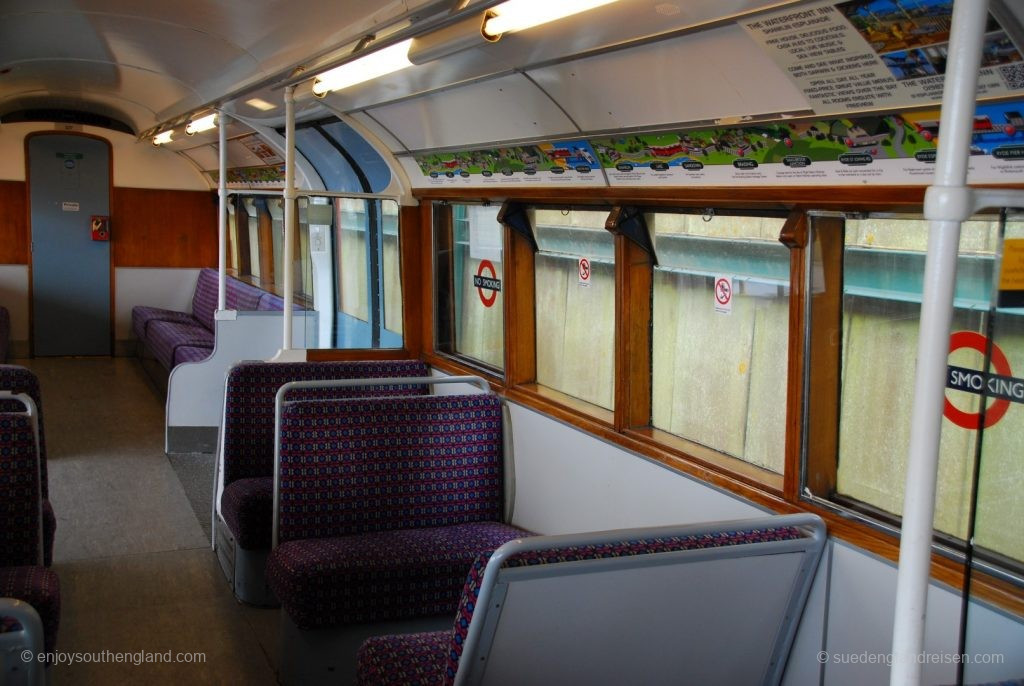
IOW Island Line -Interior view of one of the subway carriages – note the drawn description of the route with stops and points of interest attached above the windows.
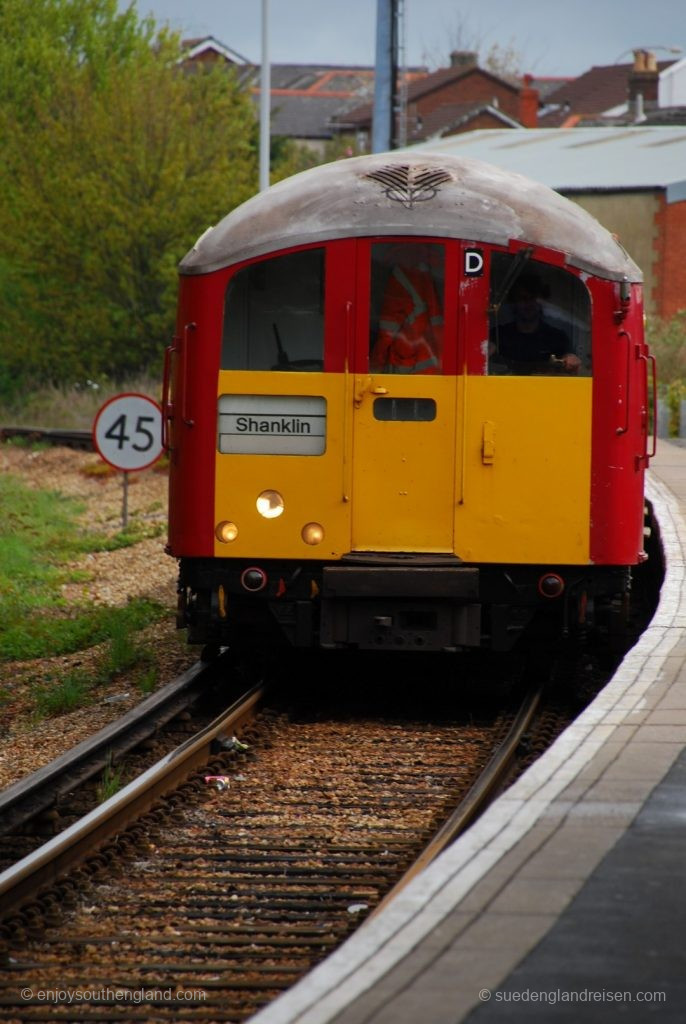
IOW Island Line – An Island Line train in the distinctive classic London Underground colors of red with yellow frontage entering Shanklin station.
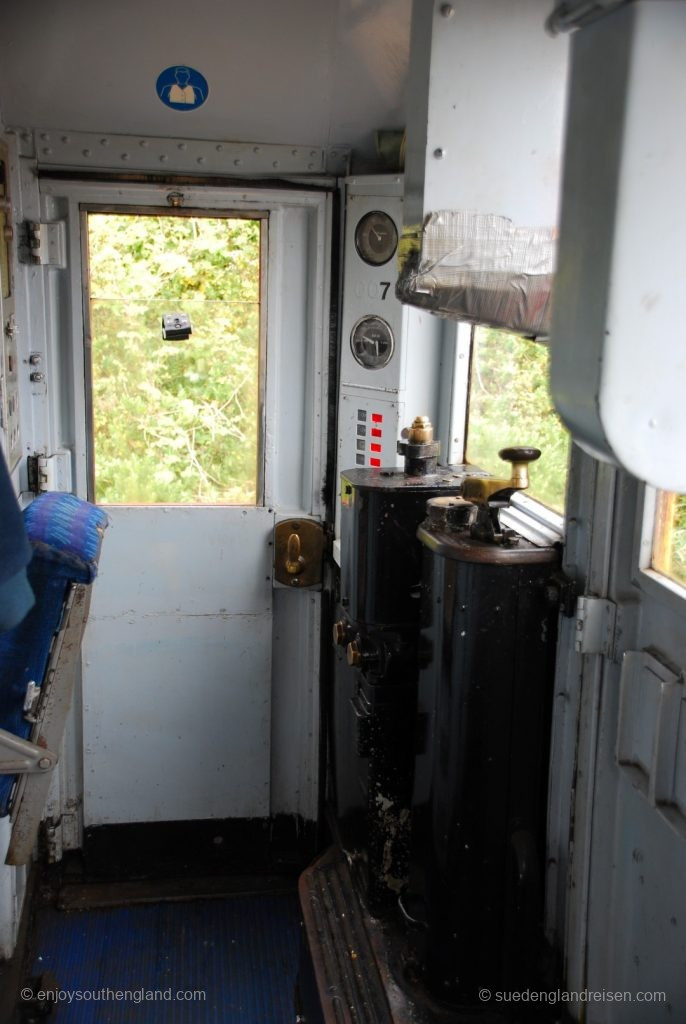
IOW Island Line – View of the driver’s cab – technology from 1938 with a modern seat.
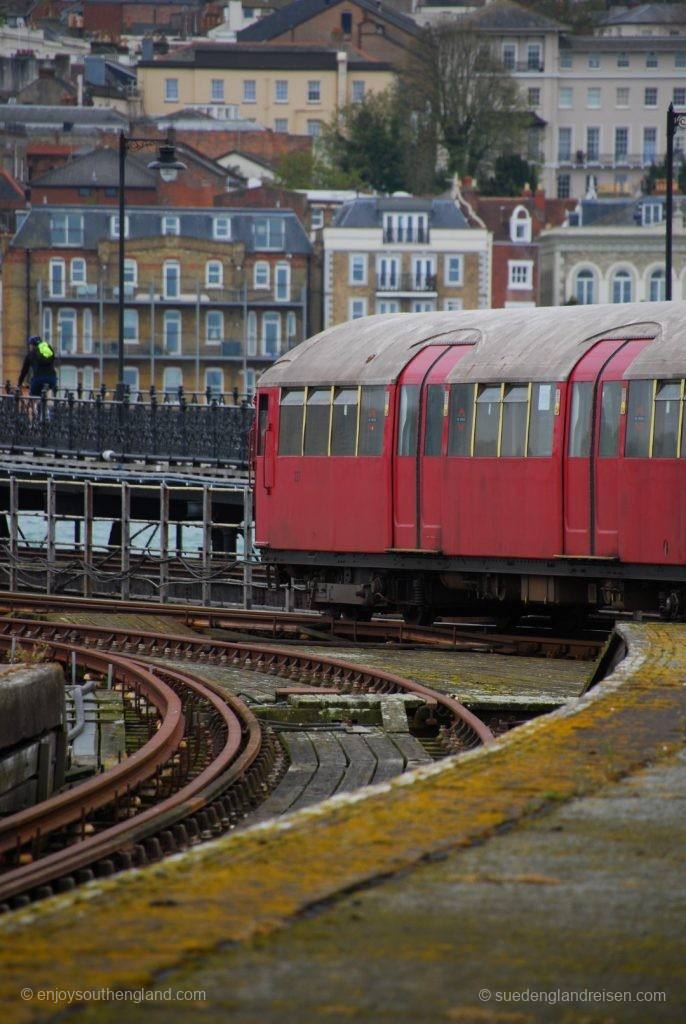
IOW Island Line – Exiting Ryde Pier Head Railway Station. In the background the city and between the train and the background the pedestrian bridge on the pier. Note the exposed power rail on the rarely used track on the left.
Travel Report:
We went to the Isle of Wight from London (Waterloo Station) via Portsmouth. The travel time to Portsmouth was 2 hours and 36 minutes and then we boarded the fast catamaran, “Red Jet”, which took us to the island in just 18 minutes. The catamaran docked at the far end of the 700-metre-long pier at the town of Ryde. Only a few metres walk through the nicely prepared waiting hall and it is possible to make a direct change to the Island Line train. At the platform, it is worth having a look at the railway tracks. The delicate substructure of the tracks means that the sea is directly visible below. Considering that the railways have their electrical equipment exposed, we understand why the railway operation on the pier sometimes has to be stopped in stormy weather. Fortunately, this is rarely the case.
In the two-track pier station, the right track 1 is usually used at all times and our train was already there waiting for us. It is a typical old London underground carriage with sliding doors pulled wide into the roof, even painted in the old brown-red London colour scheme with a yellow front. It is low and if you are more than 1.70 metres tall, you will involuntarily duck your head when boarding. Inside, the carriages are fitted with softly padded seats, positioned both longitudinally and sideways-facing to the direction of travel. If you sit down, you have a rather good impression of the space but standing can be quite constricting. Above the windows beautifully painted information boards provide descriptions of the route and highlights about each station.
These painted information boards are very typical of British railways. For example, Southwest Trains, which used to operate the line, provide a really nice overall view of the island including the privately operated steam railway. The carriages of the Island Line date back to 1938 and have only been slightly modified which means that they do not have any modern safety components and require one conductor per carriage. Because the smallest unit is double traction, three men are required. Staff are not always available and so in off-peak times one of the 40-seater wagons is often closed off in order to manage with just one conductor. By the way, railway enthusiasts prefer the rear carriage, because this is where the conductor operates the doors, makes announcements, etc. The time has come. The conductor closes the doors, and as they slowly shut, he finally gives the departure order to the driver. This is all done via an open control panel on the driverless front of the train. After just under a minute and a half and 644 metres distance on the pier we reached “Ryde Esplanade”. This is the main station on the line with a direct change to the island-wide transport network which is mostly a fleet of double-decker buses as well as the hovercraft link to Portsmouth beach. The station itself is located on a rather narrow left-hand bend and has larger station building with ticket office and tourist information.
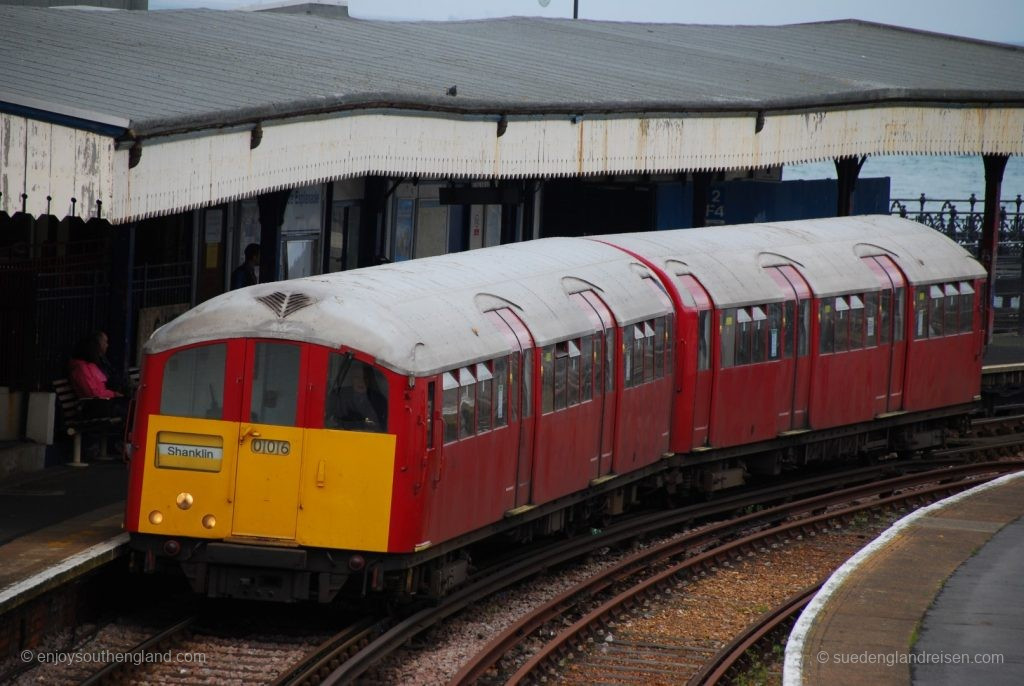
IOW Island Line – Stopping at Ryde Esplanade
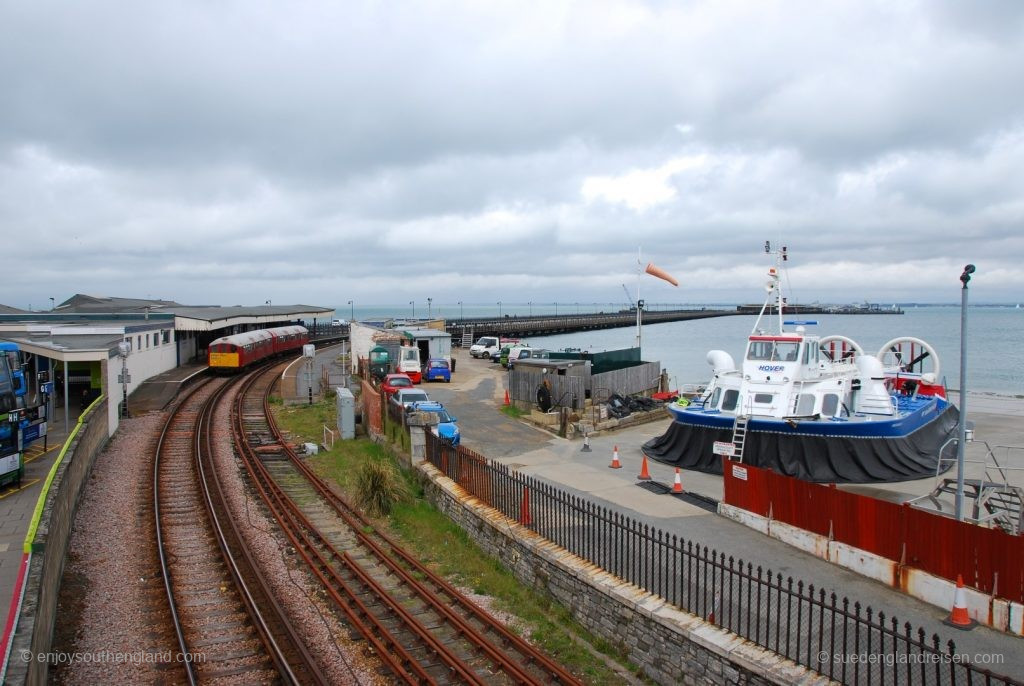
IOW Island Line – Ryde Esplanade – here you can transfer to the buses (left) and the hovercraft (right).
Directly after leaving the station, the line slopes away and is switched to the left track in the direction of travel. Shortly thereafter the tunnel, which has two lines, is reached and is a part of the construction of Ryde. (approx. 20,000 inhabitants) It also provides a route for pedestrians. After 358 meters we could see daylight again and we travelled mainly between commercial enterprises and some grassland through the eastern part of the town. After about 5 minutes travelling, we crossed St. John Street and reached the train station of the same name in Ryde. This is also the operational centre of the line, because next to the two-track passenger station with the rather rusty iron bridge is the workshop and the open sidings of the unrequired railway stock.
After the descent you think that you are already a long way out of town and the journey continues immediately into the countryside. The line is double-tracked until shortly before the next station “Smallbrook Junction” and every second train crosses here. However, this station, which can be reached after just two minutes, is mostly used for trains on the Isle of Wight Steam Railway, to which there is a direct pedestrian crossing. The tracks are not connected.
Where the steam train then turns east, our Island Line continues to move south. The journey runs through woods and meadows, where you can enjoy a travelling experience of bygone times. At its maximum speed of 45 miles per hour (about 72 km/h), the train lurches so hard that you almost fear it will jump off the rails. In addition to this, the blows of the bolted rail connections mean that if the seats were not so extraordinarily softly padded, the low ceiling of the train would have been full of dents. The conductors – from whom tickets are available at no extra charge, by the way – literally dance through the carriage during their regular ticket inspection. There is always an opportunity for a little chat, as they make time for this in their working day! In addition to this with the howling of the age-defying engines we cannot believe that this is a regular mode of transport in 2013!
Five minutes later we arrived at “Brading” station. This station was double-tracked until the end of the 1980s and used to be a branch for the freight line to the port of Bembridge and St Helen. Some of the old extensive station facilities are still preserved, including the signal box. Unfortunately, only the main platform on track 1 is connected to the track, which makes the continuous 30-minute interval impossible. The station itself conveys the wonderful morbid mood of this line like no other – just notice the intricate letters IWR (Isle of Wight Railway) in the iron platform roof racks.
We continue and at first the distance, which is covered in 4 minutes, runs through open land and then it becomes more urban. Whereas Brading Station was a bit outside the village, we now pass through Sandown (5,000 inhabitants), which is a seaside resort. The station is again double-tracked and here, too, every second train crossing takes place. The original quite extensive tracks with a junction to Newport, which was abandoned in 1956, have now been almost completely dismantled. On a single track it passes a park and already has a partial view of the sea on the left-hand side. It continues along a dam through almost continuous buildings with a journey time of only three minutes. It was not until 1987 that “Lake” station, consisting of a wooden platform, was built and since then it has been completely rebuilt. The stop directly in the countryside above the village seems almost idyllic – but don’t be deceived by it in view of the rather densely built agglomeration below.
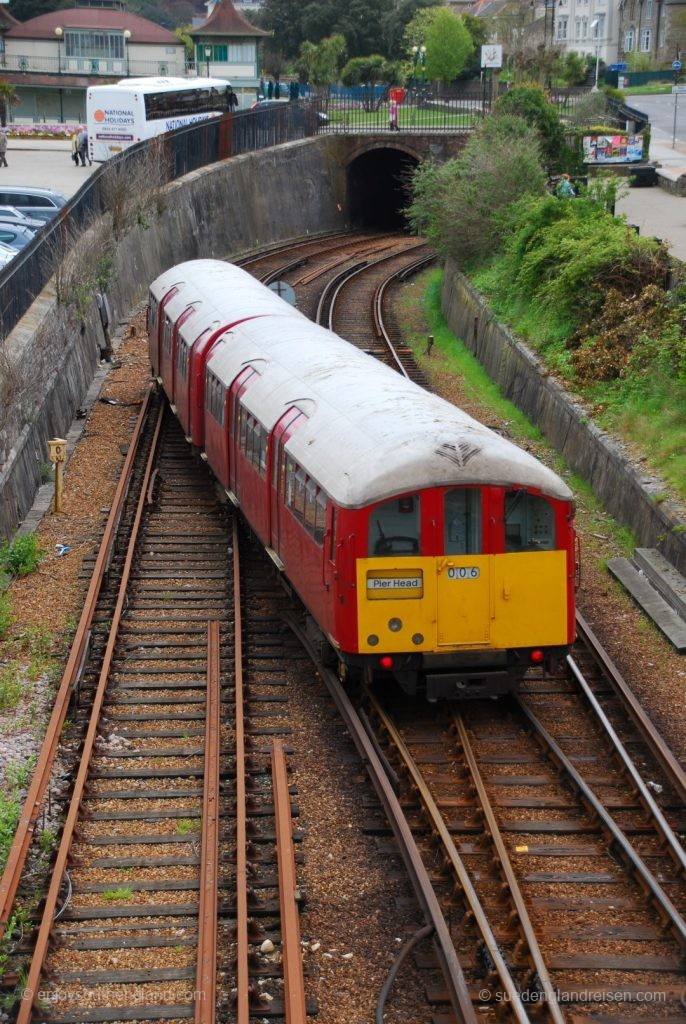
IOW Island Line – Change to the correct track from here, just before the tunnel towards Ryde St. John Street.
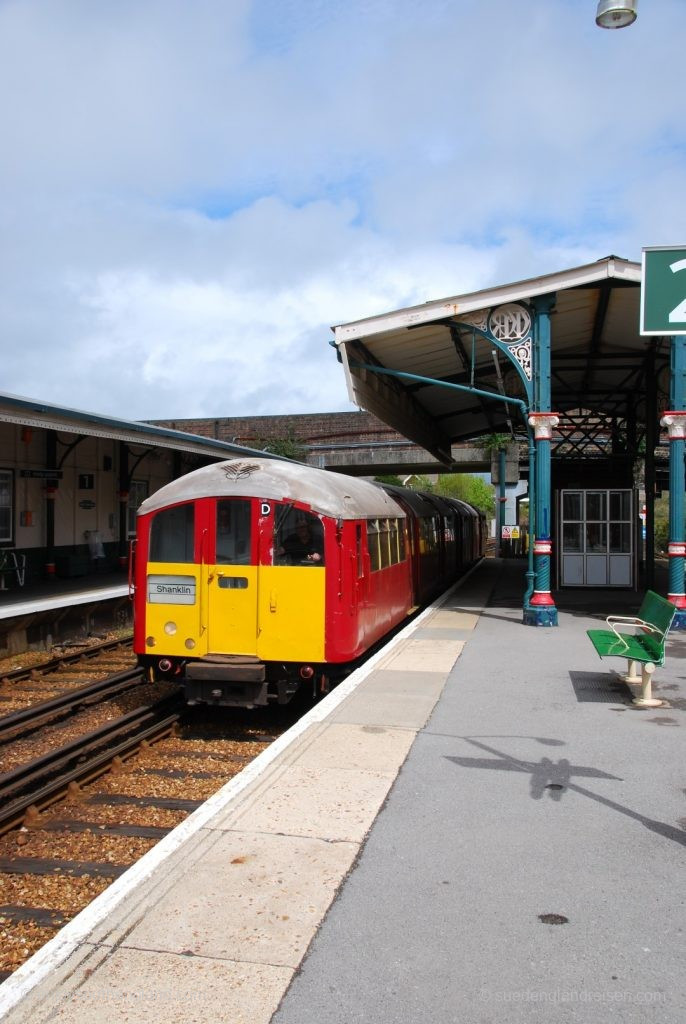
IOW Island Line – Stop at Ryde St. John Street. Note the beautiful old station architecture.
We have almost reached our destination: Another 3 minutes of the trip and directly after Lake, the view from the left-hand window is worthwhile. The cliffs and the sea can now be seen before we cross the main road and reach our destination “Shanklin” (approx. 20,000 inhabitants) on a green strip of land. This popular seaside resort on the English Channel with its long sandy beaches has an adorable old town “Shanklin Old Village” and as a natural attraction the “Shanklin Chine”, a type of gorge through the chalk cliffs towards the sea. Here our journey ended abruptly by a buffer stop directly at the abutment of a former bridge. The single-track station even has a ticket office with restricted opening times despite ticket sales on the train and in front of the station taxis wait for the arriving passengers.
Before we leave the platform and make our way through the beautiful old ticket hall on the approximately ten-minute walk into the town or to the beach, we take a look into the driver’s cab of our train. It is clearly 1938 technology: a cam switch operated with the right hand and the compressed air brake operated with the left hand. The operation is done more in a standing rather than in a sitting position, with a type of padded standing aid installed for the driver. A last look back at the train and the hope remains that we will be able to travel on this lovable route to the summer resort again.
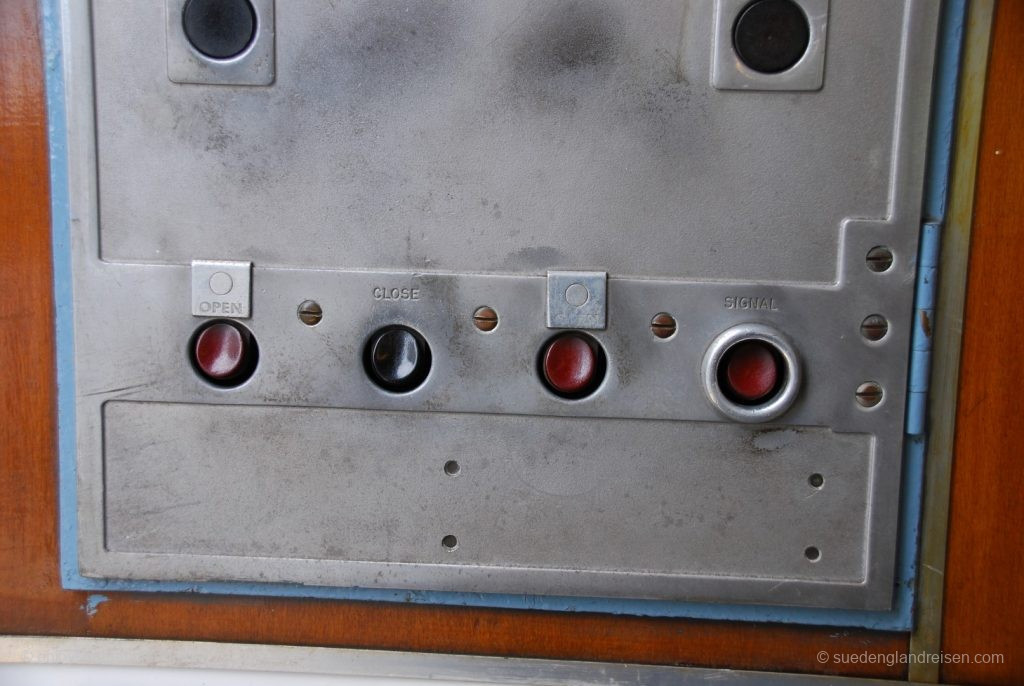
IOW Island Line – Control panel for the doors – freely accessible on the non-cab side of the carriage.
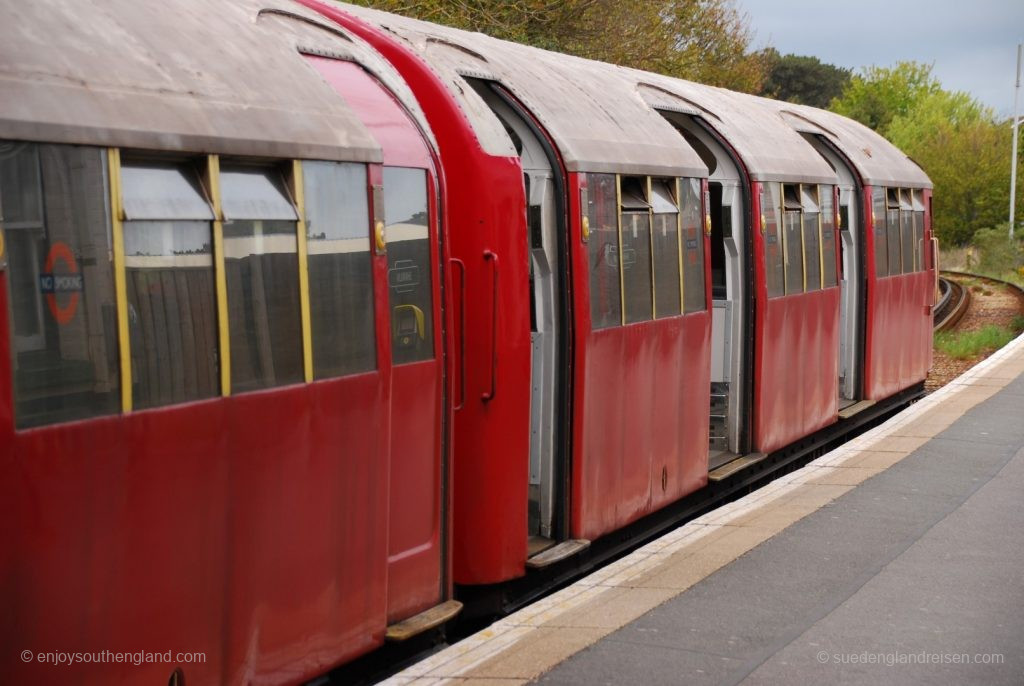
IOW Island Line – Please mind your head when boarding!
(visited in June 2013 when the 1938 rolling stock was still in use. This changed in 2021.)





